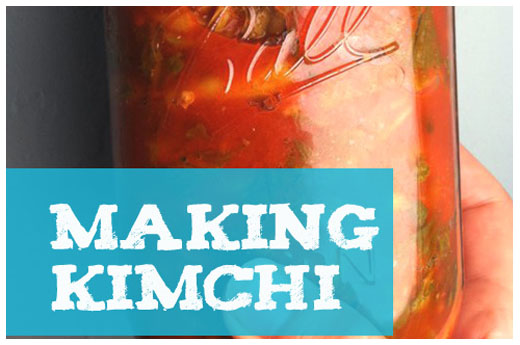
by guest blogger Robyn Jasko, cofounder of Grow Indie
Kimchi, the fiery Korean cousin of sauerkraut, is all the rage these days, showing up at your favorite health food stores and supermarkets, with jars of bright red fermented cabbage lining the shelves. This Korean superfoodhas been a cultural staple for generations—and for good reason: Kimchi is packed with healthy probiotics, enzymes, vitamins, and beneficial bacteria.
It’s also a really great way to add a little flair to your favorite foods. Many people soon find themselves addicted to the sour/spicy flavor, using it to make everything from Korean Tacos to Kimchi-Scallion Pancakes. I love to brew up a hot pot of healing Kimchi Stew when I feel a cold coming on (the hot pepper, garlic and ginger in kimchi definitely help kick out whatever ails you).
Although kimchi was traditionally buried in crocks underground while fermenting, you can easily make a batch at home with just a mason jar.
Homemade Kimchi
Ingredients:
- 1 head napa cabbage, or 2 large heads bok choy, with a few large leaves reserved
- 1 daikon radish, sliced
- 2 Tablespoons kosher salt
- 3 cloves garlic
- 1 2-inch knob ginger, peeled
- ½ cup Korean red pepper powder
- 1 chile pepper
- 1 Tablespoon sugar or 1 apple or pear
- 1 sterilized mason jar
Directions:
Place cabbage or bok choy and daikon in a large bowl and sprinkle with 2 tablespoons of kosher salt. Toss to combine, cover, then let sit at room temperature until cabbage is wilted, at least 1 hour and up to 12. It should release ¼ to ½ cup of liquid. Meanwhile, combine the garlic, ginger, red pepper powder, chile pepper, and sugar (or apple/pear if using) in the bowl of a food processor or blender. Process until a rough paste is formed, about 30 seconds total, scraping down the container’s sides as necessary. Drain cabbage and pat it dry (set liquid aside) then mix the cabbage with the paste. Pack kimchi and some of the liquid into your mason jar, pressing the cabbage down firmly with a wooden spoon so the brine covers the top. Add more water if needed to make sure the mixture is completely covered and submerged. Add the reserved large cabbage leaf to the top and leave at least an inch of headspace in your jar.
Seal the jars tightly and allow them to sit at cool room temperature (65 to 75 degrees is ideal) for 3 to 5 days, tasting every few days to see if the kimchi is ready. When it develops a sour, spicy taste and a texture similar to sauerkraut, remove the big cabbage leaf and store the jar in the fridge.
Grow Your Own Kimchi Garden
Kimchi is so versatile—it can be made of almost whatever crunchy vegetables you are harvesting and makes short work of those extra carrots, cabbages, broccoli rabe, chives, radishes, peppers, kale, and cucumbers that may be overwhelming your garden in late summer or fall. Or, you can even plant a kimchi garden that includes napa cabbage, daikon, and carrots (for an interesting spin-off of a salsa garden).
Although napa cabbage is ideal for making kimchi, it can be a bit difficult to grow and takes up to 80 days to harvest. Bok choy is a fantastic fill-in, ready in just 45 days—and even sooner if you grow the dwarf, or “baby,” bok choy variety, which can be picked as early as at 30 days. Bok choy is also easier to grow and takes up a lot less space than cabbage, making it a perfect choice for containers or small-space gardens.
Daikon radishes are a kimchi favorite, too, but if you are short on time and space, or just new to growing, ‘Saxa 2‘ radishes are the easiest, earliest radishes I have ever grown and are ready in just 3 weeks!
Experiment with making different kinds of kimchi. There are no strict rules, and it’s always fun to make up your own tasty varieties.
 Robyn Jasko, creative services director at Runner’s World magazine at Rodale, is a local-foods activist, community garden starter, and cofounder of Grow Indie, a site promoting sustainable lifestyles, homesteading, eating well, and living local. Her first book, Homesweet Homegrown: How to Grow, Make and Store Food, No Matter Where You Live, was released May 2012.
Robyn Jasko, creative services director at Runner’s World magazine at Rodale, is a local-foods activist, community garden starter, and cofounder of Grow Indie, a site promoting sustainable lifestyles, homesteading, eating well, and living local. Her first book, Homesweet Homegrown: How to Grow, Make and Store Food, No Matter Where You Live, was released May 2012.




Can you make Kimchi without garlic??
Can you make kimchi without garlic?
Hi Kim! Yes, you definitely can make it without garlic—kimchi is very versatile, so you can leave out whatever veggies you don’t like, and use what’s fresh and in season.
Thanks! I will grow the BokChoy and Daikon for this. I have been thinking about making KimChee for a few years. I smoke fish, grind and smoke sausage, Garden, make pickled peppers and Pickles. This will add much flavor for my lower-fat diet.
Can you ‘can’ Kimchee after it has fermented??
Hey I know this is off topic but I was wondering if you knew of any widgets I could add to my blog that
automatically tweet my newest twitter updates.
I’ve been looking for a plug-in like this for quite some time and was hoping maybe
you would have some experience with something like this.
Please let me know if you run into anything. I truly enjoy reading your blog and
I look forward to your new updates.
Hi there, all is going fine here and ofcourse every one is sharing
facts, that’s in fact good, keep up writing.
This is the perfect website for everyone who wants
to find out about this topic. You realize so much its almost hard to argue with you (not that I really
would want to…HaHa). You certainly put a new spin on a subject that’s
been discussed for years. Great stuff, just excellent!
If you want to get to a mastery level of interacting with
hot women, if you want to keep the attraction going once
you’ve got your foot in the door, then just trust me
– check out what Joshua’s going to tell you about
it:
Shopper Approved is based on the powerful concept called ‘social proof’, which states that:
When a potential customer goes online to buy a product or service, they actually want and actively
look for reassurance that they’re making the right decision. And the way they get that
assurance is
from other customers’ ratings, feedback, and reviews.
This is why statistically, 77% of online shoppers turn to consumer reviews before they decide to buy!
There’s a reason why Amazon, eBay, Sears, and pretty much every other major ecommerce site
have customer
ratings and reviews integrated into their website.
It’s because online reviews have been proven to increase
conversion, increase average transaction amounts, improve customer satisfaction, and even lower product
returns!
Check Out The Link In Signature
Having spent, as one of Uncle Sam’s Army, 26 months in Korea, South, and having eaten Kimshi both winter and summer as well as cucumber, radish and peanuts with squid and various other foods, I prefer winter kimchi made with NAPA cabbage. Nothing really hits the spot, spot on, as winter kimchi. Don’t get me wrong, there is nothing wrong with the other treats, but a good and fermented winter cabbage is what, to my taste, is what Kim is all about. In second place a fiery red cucumber kim is what it is also all about. And as with all Kim’s, the more rotten smelling the better, unless of course it is truly rotten. In general tho the more rotten it smells the better it will taste and tomorrow will remind you of that fact when you take to the throne. Something is truly rotten in lower Denmark. And God Bless Uncle Sam for the education he gave me from east to west and north to south for 20 plus years. Squid and peanuts with a Korean Crown beer are also GREAT!
My last tour in Korea, South, was in during the 1970’s and so much has changed as seen on TV. My female barber is Korean and she goes back every other year and visits family in Seoul. She gives me a blow by blow synopsis after all trips. I have to say I would not even recognize the place were I able to return and how I wish I were able. One of my fondest memories of Korea was the Korean Greyhound Transit Line. Real live and running, US built and painted Greyhound busses running up and down the only highway of the time from Seoul to Pusan. And like the Blue Train, blue and vanilla in color, and also US built, they stopped for nothing short short of a disaster or a scheduled stop. Get out of the way or pay the price. Man oh man, it was excitement on a personal level, at the time. Just wanted to add that and the fact that back then the Koreans were some of the hardest working people on the face of the planet as well as some of the most brutal which they learned to be courtesy of Japanese occupation. I’m done now.
Hi! I love how informative and great your articles are. Can you recommend any other Food Blog Names or blogs that go over the same topics? Thanks a lot!